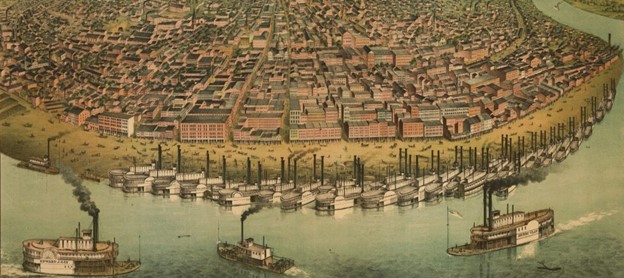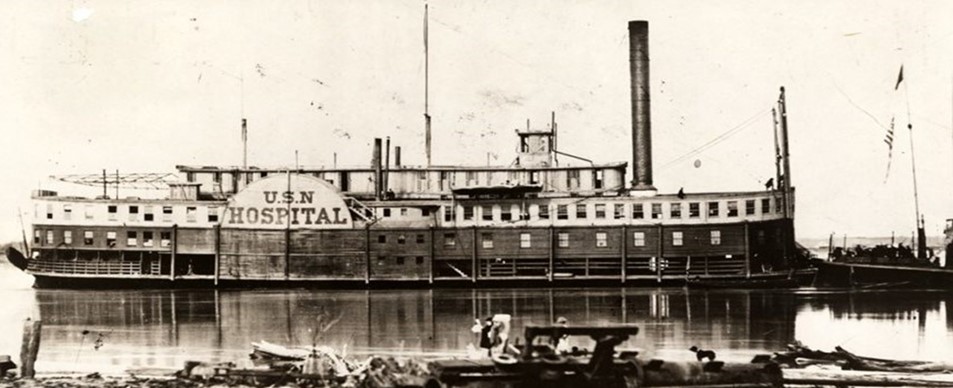Table of Contents
At the outbreak of the Civil War, the Union (and Confederates) had no established naval hospital ships to transport wounded soldiers via waterways. America’s waterways were not only valuable for the transport of economic goods, but they were also an efficient way to transport wounded from the front to well-protected hospitals in cities. Early in the war, Commanding General of Union forces Winfield Scott instituted his “Anaconda Plan” which was designed to surround the majority of the Confederate States and slowly squeeze inwards. The Union easily took control of the Atlantic coast and began to occupy the Gulf Coast. The Mississippi River would not be under the full control of the Union until after General U.S. Grant’s victory at Vicksburg in 1863, however, the Union had already controlled the vast majority of the Mississippi.

The majority of naval ships in both Union and Confederate naval services did have surgeons on board, however, military hospital ships began in the United States during the Civil War. Hospital ships would usually join naval detachments to provide additional medical support or be stationed in nearby waterways during land battles to transport wounded soldiers off the field. The ships used, mainly steamers and civilian transport ships, were converted to include spaces for patients, rooms for surgical operations, and crew quarters. These ships, depending on size, would have a full staff of surgeons and physicians as well as plenty of stewards and nurses to assist in patient care.

By the time of Union General George McClellan’s Virginia campaign of 1862, the Union began using civilian steamboats and captured Confederate ships as hospitals. One of the most well-known Union hospital ships was one of these captured Confederate ships, the Red Rover. Another famous Union hospital ship was the Memphis which was most active during the Battles of Fort Henry, Fort Donelson, and Shiloh. The Memphis carried over 7,000 wounded from these battles to Northern cities over fourteen trips. Assistant Surgeon W.D. Turner, who served on the Memphis, performed 78 operations on these voyages. Remarkably, out of the over 7,000 patients transported on the Memphis from these battles, only 125 died.[1]
Early in the war, many hospital ships were operated and staffed by either the United States Sanitary Commission or the Western Sanitary Commission. This allowed the ships to be fully stocked with medical supplies and staffed by plenty of medical personnel. Over time, both sanitary commissions gave their hospital ships to the federal government. Ships like the Red Rover, The Memphis, and The State of Maine were some of those ships originally operated by the USSC later to be turned over to the Union Army.

One ship that was not originally operated by either commission was the first Union-designated hospital ship, the D.A. January, with Assistant Surgeon Alexander H. Hoff in charge of its medical operations. The D.A. January “was fitted with 450 beds, an operating room, running water, bathrooms, a laundry room, and cooking facilities with a medical staff of civilian and military doctors and nurses.”[2] Throughout its service during the Civil War, the D.A. January treated and transported an estimated 24,000 soldiers.
One soldier transported by the D.A. January was Private W. H. Bulla, Co. F, 2nd Iowa Cavalry who was wounded at Farmington, Mississippi in 1862. Private Bulla’s wound was recorded in the field as a “wound of the thigh and rectum by ball.” He was taken to the D.A. January to be transported to a general hospital in St. Louis then later to Jeffersonville where he received a commission as a lieutenant. After being furloughed, now Lieutenant Bulla was examined by a pension examiner who described the injury as “the ball entered the lower third of the right thigh, passed upward and inward of the posterior face of the femur, and is now lodged in the thigh… A second ball entered on the right side of the anus, and was cut out from the coccygeus… The third ball passed just under the patella lodged on the tibia, and was cut out from the left leg. His general health is excellent; total disability.”[3]
These hospital ships operated much like a general hospital did with the only difference being a hospital ship’s ability to move locations and transport a large number of wounded soldiers. Surgeons on board were able to perform any possible surgery on soldiers coming in from the front. Depending on the size of the ship and the available staff, patients on board were able to receive more attention from their caregivers.
Today, the United States Navy operates two designated hospital ships, the USNS Mercy and USNS Comfort. During the height of the COVID-19 pandemic, the Mercy and Comfort were dispatched to the harbors of New York City and Los Angeles to assist in any way they could. Hospital ships across the world today are sent to help support overwhelmed medical professionals in times of crisis.
About the Author
Michael Mahr was the Education Specialist at the National Museum of Civil War Medicine from 2021 to 2024. He is a graduate of Gettysburg College Class of 2022 with a degree in History and double minor in Public History and Civil War Era Studies. He was the Brian C. Pohanka intern as part of the Gettysburg College Civil War Institute for the museum in the summer of 2021.
Sources
[1] Bollet, Alfred Jay. Civil War Medicine: Challenges and Triumphs. Galen Press, 2002.
[2] “Museum Exhibits Manager Chronicles the History of U.S. Hospital Ships.” National Museum of Health and Medicine. Accessed November 28, 2023. https://medicalmuseum.health.mil/index.cfm?p=media.news.article.2019.manager_chronicles_hospital_ships_history.
[3] The Medical and Surgical History of the War of the Rebellion. Washington: U.S. G.P.O., 1888. Vol. 2 Part 2. Page 311


